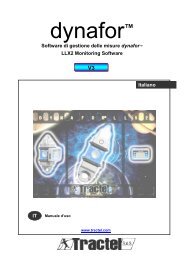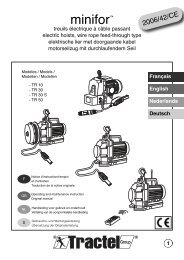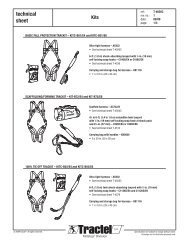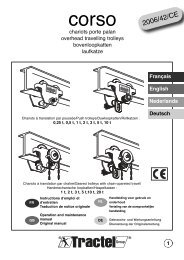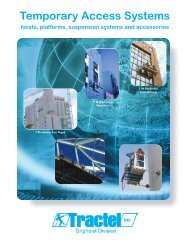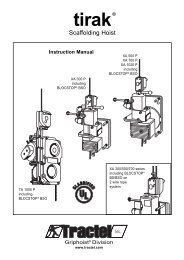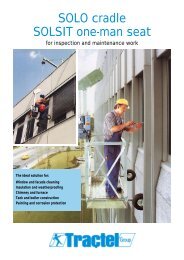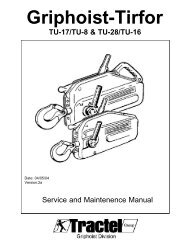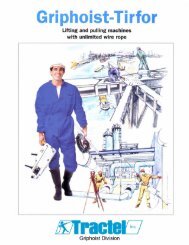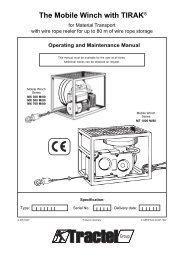User instructions - Tractel
User instructions - Tractel
User instructions - Tractel
You also want an ePaper? Increase the reach of your titles
YUMPU automatically turns print PDFs into web optimized ePapers that Google loves.
HF 32/1/A Universal load cell<br />
Including wiring for 2 trip points<br />
Operating<br />
equipment in<br />
accordance with<br />
CE directives<br />
and<br />
maintenance<br />
manual<br />
MS 32/1/A R 03/03<br />
1
GENERAL WARNING 2<br />
INSTALLATION OF HF 32 LOAD CELL 3 – 4 - 5<br />
OPERATION AND ADJUSTMENT OF HF 32 LOAD CELL 6<br />
WIRING OF HF 32 TWO TRIP POINTS 7<br />
GENERAL WARNING<br />
1- Reading and fully understanding the technical data sheets relating to this<br />
equipment is essential for the best use of this high technological material<br />
that you have received . All the technical data sheets are available on<br />
request.<br />
2- Before installing and operating Dynasafe equipment it is essential for the<br />
safe and correct operation of the material that this manual be read and fully<br />
understood and that all the <strong>instructions</strong> be followed. This manual should be<br />
made available to every operator. Extra copies of this manual will be<br />
supplied on request.<br />
3- The installation and the operation Dynasafe equipment should only be<br />
carried out in accordance with the appropriate health and safety at work<br />
regulations.<br />
4- Never apply to the Dynasafe a load or an effort in excess of the working<br />
load limit, and never use it for an operation for which it is not intended.<br />
5- TRACTEL S.A.S declines any responsibility for the consequences of<br />
dismantling or altering the machine by any unauthorized person.<br />
6- Dynasafe equipment must not be used in explosive atmospheres.<br />
7- Dynasafe equipment must only be used in a system designed for lifting<br />
people after ensuring that the appropriate operating coefficients have be<br />
used in accordance with the current regulations.<br />
8- Prior to the use of Dynasafe equipment with complementary equipment<br />
relaying the signals to an operating system, the user or installer of this<br />
system should carry out a specific risk analysis of the operating functions.<br />
The appropriate measures should be taken to obviate risks identified.<br />
MS 32/1/A R 03/03<br />
2
INSTALLATION OF HF 32/1/A LOAD CELL<br />
M<br />
A<br />
L<br />
K<br />
B<br />
C<br />
D<br />
J<br />
I<br />
E<br />
N<br />
H<br />
G<br />
F<br />
Fig. 1<br />
Components of the load cell<br />
A- 2 m connecting cable<br />
B- Flat washer.<br />
C- Adjusting pin.<br />
D- Locking ring.<br />
E- Load cell body.<br />
F- Tare screw<br />
G-.Locking nut<br />
H-Traction part.<br />
I- Safety washer.<br />
J- Tightening screw.<br />
K-Tightening bracket.<br />
L-Rubber compression pad.<br />
M-Wire rope.<br />
N- Fixing screws for circuit<br />
breaker.(do not touch)<br />
Procedure for installing load cell<br />
Essential condition : the hook of the lifting system should be free of any load.<br />
- Position the adjusting pin as a function of the load range and wire rope diameter (see p. 4).<br />
- Remove the tightening bracket (K).<br />
- Position the load cell on the wire rope near the dead end/fixed point. The connecting cable<br />
should be uppermost.<br />
- Replace the tightening bracket (K) ensuring that it is correctly positioned depending on the<br />
diameter of the wire rope. (See page 4)<br />
-Adjust the tightening screws (J) symetrically (+/- 0.5 kgm) to ensure that there is no risk of<br />
moving the load cell out of line with the wire rope. Excessive tightening may break the<br />
bracket.<br />
- Operate the lifting system up to the upper limit switch and ensure that the sheaving or<br />
bottom block does not foul the load cell. If this happens adjust the upper limit switch so that<br />
there is an appropriate distance between the load cell and the bottom block. Also check that<br />
when the bottom block is in the upper position the load cell is not in contact with the<br />
overhead crane.<br />
- Wire the connecting cable from the load cell t the control box. Ensure that the cable is<br />
secured.<br />
MS 32/1/A R 03/03<br />
3
INSTALLATION OF HF 32/1/A LOAD CELL<br />
Positioning the adjusting pin as a function of the effort in the wire rope<br />
For wire rope from 5 mm to 8 mm diameter<br />
and for loads ranging from 250 kg to 900 kg.<br />
For wire rope from 9 mm to 13 mm diameter<br />
and for loads ranging from 500 kg to 1800 kg.<br />
For wire rope from 14 mm to 16 mm diameter<br />
and for loads ranging from 700 kg to 3000 kg.<br />
Fig. 2<br />
Important remarks<br />
- Before loading and if no preadjustment has been made in the factory, unscrew the<br />
adjustment screw at the most, because you risk to destroy the transducer.<br />
- To select pin and bracket position, load has priority over wire rope diameter.<br />
- Never remove the locking nut (G) because tare screw (F) could damage the<br />
microswitch.<br />
MS 32/1/A R 03/03<br />
4
INSTALLATION OF HF 32/1/A LOAD CELL<br />
Correct positioning of the tightening bracket<br />
depending on the diameter of the wire rope.<br />
5 mm to 8 mm wire rope<br />
without the rubber compression pad,<br />
M6 screws * 30mm (supplied)<br />
M6 screws * 30 mm (x2)<br />
9 mm to 16 mm wire rope<br />
without the rubber compression pad,<br />
M6 screws * 35mm (supplied)<br />
Rubber compression pad<br />
M6 screws * 35 mm (x2)<br />
Fig. 3<br />
MS 32/1/A R 03/03<br />
5
OPERATION AND ADJUSTMENT OF HF 32 LOAD CELL<br />
Earth<br />
(Brown)<br />
(Blue)<br />
(Black)<br />
Lifting<br />
Contactor<br />
Alarm<br />
Control<br />
voltage<br />
G<br />
BROWN/BLUE = NC (Normally closed)<br />
BROWN/BLACK = NO (Normally open)<br />
Fig.4<br />
The switching power is 4A, 220 Vac (0.3A, 250 Vdc). ( It is therefore possible to<br />
connect in series in the upper limit switch circuit).<br />
Adjustment of the safety trip point<br />
Essential conditions :<br />
Equipment required :<br />
- The load cell must be correctly installed and wired.<br />
- The hook of the lifting system should be free of any load.<br />
- A load (“Pm”) equivalent to 100 % of the working load limit<br />
of the lifting system .<br />
- An additional load equivalent to 10 % of « Pm ».<br />
ACTION<br />
1 Lift the two loads<br />
(100% + 10% of Pm)<br />
by +/- 10 cm.<br />
2 To adjust the safety<br />
trip point.<br />
EXPLANATION<br />
The additional 10 % load represents the overload value<br />
permitted under the European directives.<br />
If an overload situation is detected in the wire rope ( without<br />
lifting the loads) the preadjustment of the load cell in the<br />
factory is too low for your lifting system.<br />
Solution: release the tare screw (F - see fig. 4) one turn at a<br />
time and restart at the beginning of point 1.<br />
Use the tare screw (F).<br />
Warning : incorrect adjustment may damage the circuit –<br />
breaker.<br />
Do not forget the locking nut (G). The switch is a normally<br />
closed contact (NC), requiring the opening of the switch to set<br />
off an overload condition.<br />
Turn clockwise to reduce the value of the trip point.<br />
Turn anticlockwise to increase the value of the trip point.<br />
MS 32/1/A R 03/03<br />
6
INSTALLATION OF HF 32 / . / A . TWO TRIP POINTS<br />
M<br />
Components of the load cell<br />
L<br />
K<br />
J<br />
I<br />
H<br />
A<br />
B<br />
C<br />
D<br />
E<br />
N<br />
F<br />
G<br />
F'<br />
G'<br />
S 1<br />
S 2<br />
A – Cable connection.<br />
B – Flat washer.<br />
C – Adjust pin.<br />
D – Locking ring<br />
E – Load cell body.<br />
F – Tare screw for trip point N° 1.<br />
G – Locking nut for trip N° 1.<br />
F’ - Tare screw for trip point N° 2.<br />
G’ - Locking nut for trip N° 2.<br />
H –Traction part.<br />
I – Safety washer.<br />
J – Tightening screw.<br />
K – Tightening bracket.<br />
L – Rubber compression pad.<br />
M – Wire rope.<br />
N – Fixing screws for circuit-breaker.<br />
The individual adjustment of each trip point must be carried out as<br />
explained in this manual for the one trip point models.<br />
WIRING<br />
Trip point 1( intermediary )<br />
GREEN / BROWN : NC ( 4 A 220 Vac )<br />
WHITE/ BROWN : NO ( 4 A 220 Vac)<br />
Trip point 2 ( Safety )<br />
BLUE / GREY : NC ( 4 A 220 Vac )<br />
PINK / GREY : NO ( 4 A 220 Vac )<br />
MS 32/1/A R 03/03<br />
7
NOTES :<br />
MS 32/1/A R 03/03<br />
8



